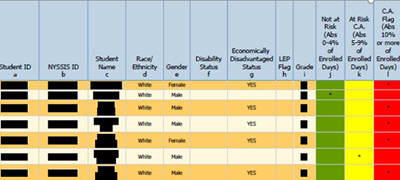


What's measured?
@ the student level...
the year-to date number of absences for any reason as a percentage of the total number of school days enrolled.
How does it inform?
________________________________________________________________________________________
@ the school level...
the year-to date number of students whose rate of absence is 10% or greater as a percentage of the total number of students enrolled anytime during the school year.
The New York State Education Department (NYSED) has developed attendance and chronic absence verification reports, available in L2RPT Report Guides. These reports provide school leadership with information about the individual students who are chronically absent and highlight chronic absence rates for schools, classrooms and various student groups (e.g., race/ethnicity, gender, ability level, language proficiency, migrant status).
For more detailed information, review:
